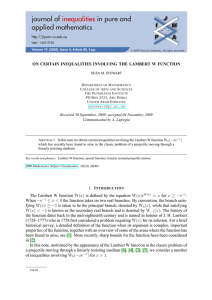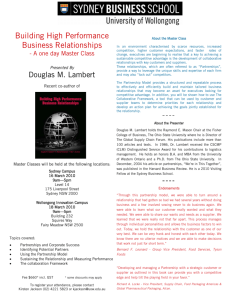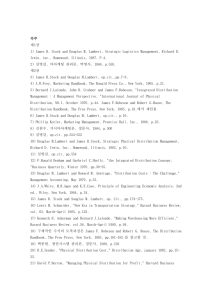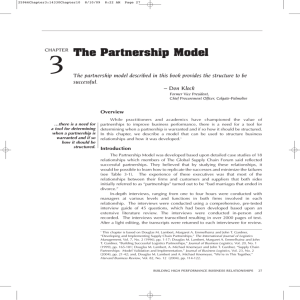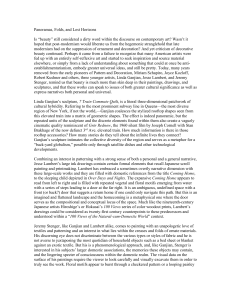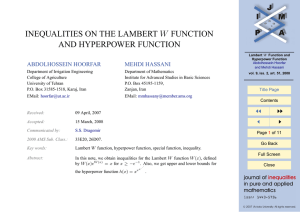ON CERTAIN INEQUALITIES INVOLVING THE LAMBERT W FUNCTION SEÁN M. STEWART
advertisement
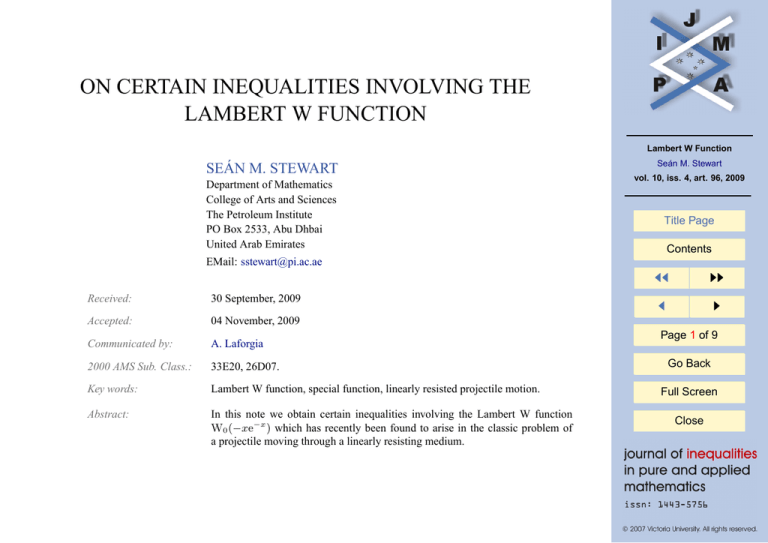
ON CERTAIN INEQUALITIES INVOLVING THE LAMBERT W FUNCTION Lambert W Function SEÁN M. STEWART Department of Mathematics College of Arts and Sciences The Petroleum Institute PO Box 2533, Abu Dhbai United Arab Emirates Seán M. Stewart vol. 10, iss. 4, art. 96, 2009 Title Page Contents EMail: sstewart@pi.ac.ae Received: 30 September, 2009 Accepted: 04 November, 2009 Communicated by: A. Laforgia 2000 AMS Sub. Class.: 33E20, 26D07. Key words: Lambert W function, special function, linearly resisted projectile motion. Abstract: In this note we obtain certain inequalities involving the Lambert W function W0 (−xe−x ) which has recently been found to arise in the classic problem of a projectile moving through a linearly resisting medium. JJ II J I Page 1 of 9 Go Back Full Screen Close Contents 1 Introduction 3 2 Preliminaries 4 3 Main Results 5 Lambert W Function Seán M. Stewart vol. 10, iss. 4, art. 96, 2009 Title Page Contents JJ II J I Page 2 of 9 Go Back Full Screen Close 1. Introduction The Lambert W function W(x) is defined by the equation W(x)eW(x) = x for x ≥ −e−1 . When −e−1 ≤ x < 0 the function takes on two real branches. By convention, the branch satisfying W(x) ≥ −1 is taken to be the principal branch, denoted by W0 (x), while that satisfying W(x) < −1 is known as the secondary real branch and is denoted by W−1 (x). The history of the function dates back to the mid-eighteenth century and is named in honour of J. H. Lambert (1728–1777) who in 1758 first considered a problem requiring W(x) for its solution. For a brief historical survey, a detailed definition of the function when its argument is complex, important properties of the function, together with an overview of some of the areas where the function has been found to arise, see [1]. More recently, sharp bounds for the function have been considered in [2]. In this note, motivated by the appearance of the Lambert W function in the classic problem of a projectile moving through a linearly resisting medium [6], [4], [3], [5], we consider a number of inequalities involving W0 (−xe−x ) for x > 1. Lambert W Function Seán M. Stewart vol. 10, iss. 4, art. 96, 2009 Title Page Contents JJ II J I Page 3 of 9 Go Back Full Screen Close 2. Preliminaries From the defining equation for the Lambert W function it is readily seen that W0 (−e−1 ) = −1, W0 (0) = 0, and W0 (e) = 1. Also, implicit differentiation of the defining equation yields d W(x) e−W(x) W(x) = = , dx x(1 + W(x)) 1 + W(x) Lambert W Function Seán M. Stewart where we note that the singularity at the origin is removable. For the principal d branch, as W0 (x) > −1 and e−W0 (x) > 0 for x > −e−1 , dx W0 (x) > 0 for x > −e−1 and consequently W0 (x) is strictly increasing for x > −e−1 . vol. 10, iss. 4, art. 96, 2009 Title Page Contents JJ II J I Page 4 of 9 Go Back Full Screen Close 3. Main Results Lemma 3.1. For x ≥ 1, we have (3.1) −1 ≤ W0 (−xe−x ) < 0, with equality holding for x = 1. Proof. For x > 1, let g(x) = −xe−x . Since e−x > 0 one has g(x) < 0 for x > 1 and we need only show g(x) increases for x > 1 such that g(x) > −e−1 as W0 (x) d is strictly increasing for x > −e−1 . Since dx g(x) = (x − 1)e−x > 0 for x > 1, g(x) clearly increases and consequently g(x) > g(1) = −e−1 . Thus −e−1 < −xe−x < 0 from which (3.1) follows. Trivially, equality on the left hand side holds only for x = 1. Lambert W Function Seán M. Stewart vol. 10, iss. 4, art. 96, 2009 Title Page Theorem 3.2. For x ≥ 1, we have (3.2) x − 2 ≥ W0 (−xe−x ), with equality holding only for x = 1. Proof. For x > 1, let U (x) = (x−2)ex−2 +xe−x and let t = x−1 so that t > 0. Then U (t) = e−1 h(t) where h(t) = (t − 1)et + (t + 1)e−t . Since dtd h(t) = 2t sinh t > 0 for t > 0, one has h(t) > h(0) = 0, or, equivalently (x − 2)ex−2 > −xe−x for x > 1. Since W0 (x) is strictly increasing for x > −e−1 and as −xe−x > −e−1 for x > 1 (see Lemma 3.1), it is immediate that W0 ((x − 2)ex−2 ) > W0 (−xe−x ). Finally, since x−2 > −1, the desired result follows on recognising the simplification W0 ((x − 2)ex−2 ) = x − 2, with equality at x = 1. Theorem 3.3. For x > 1, we have (3.3) 1< x + W0 (−xe−x ) < 2. x−1 Contents JJ II J I Page 5 of 9 Go Back Full Screen Close Proof. For x > 1, combining the left hand side of inequality (3.1) with (3.2) gives −1 < W0 (−xe−x ) < x − 2. Adding x to each term appearing in the inequality before dividing throughout by x − 1 > 0 for x > 1, yields the desired result. Lemma 3.4. For x ≥ 1, we have (3.4) xW0 (−xe−x ) + 1 ≥ 0, with equality holding only for x = 1. Proof. For x > 1, let g(x) = xW0 (−xe−x ) + 1. As d W0 (−xe−x )(x − 2 − W0 (−xe−x )) g(x) = − , dx 1 + W0 (−xe−x ) d from (3.1) and (3.2), we have dx g(x) > 0 for x > 1 and consequently g(x) > g(1) = 0, with equality holding only at x = 1. This completes the proof. Theorem 3.5. For x ≥ 1, we have (3.5) 2 ln x − x ≤ W0 (−xe−x ) ≤ 2 ln x − 1, with equality holding only for x = 1. Proof. Consider the function f (x) = 2 ln x − x − W0 (−xe−x ) for x ≥ 1. As d x − 2 − W0 (−xe−x ) f (x) = − , dx x(1 + W0 (−xe−x )) d from (3.1) and (3.2) it is clear that dx f (x) < 0 for x > 1 and consequently f (x) < f (1) = 0, which gives the left hand side of (3.5). Trivially, equality only holds for x = 1. Lambert W Function Seán M. Stewart vol. 10, iss. 4, art. 96, 2009 Title Page Contents JJ II J I Page 6 of 9 Go Back Full Screen Close For the right hand side, proceeding in a similar manner, we let g(x) = 2 ln x − 1 − W0 (−xe−x ) for x ≥ 1. Again, since (xW0 (−xe−x ) + 1) + (W0 (−xe−x ) + 1) d g(x) = , dx x(1 + W0 (−xe−x )) d from (3.1) and (3.4), it is immediate that dx g(x) > 0 for x > 1. Thus g(x) > g(1) = 0 with equality holding only for x = 1, giving the right hand side of (3.5). This completes the proof of the theorem. 0< Seán M. Stewart vol. 10, iss. 4, art. 96, 2009 Corollary 3.6. For x > 1, we have (3.6) Lambert W Function x + W0 (−xe−x ) − 2 ln x < 1. x−1 Title Page Contents Proof. Rearranging terms in (3.5) followed by dividing throughout by x − 1 > 0 for x > 1, the result follows. JJ II Theorem 3.7. For x > 1, we have J I (3.7) (x + W0 (−xe−x ))2 > 8. x − 1 − ln x Proof. Consider the function L(x) = simplifying gives −x (x+W0 (−xe−x ))2 x−1−ln x Page 7 of 9 Go Back for x > 1. Differentiating and Full Screen Close −x d 1 + xW0 (−xe ) + 2 ln x − x − W0 (−xe ) L(x) = − dx x(1 + W0 (−xe−x )) −x x + W0 (−xe ) x − 1 − ln x 2 . From the left hand side of (3.1), since x > 1 it is clear that −1 < W0 (−xe−x )/x, or x + W0 (−xe−x ) > 0 for x > 1. Also, trivially, x − 1 > ln x for x > 1. Hence d the squared term appearing in dx L(x) is non-zero and therefore always positive. Its denominator is also positive since from (3.1) one has 1 + W0 (−xe−x ) > 0 for x > 1. To show that the numerator is negative for x > 1, let g(x) = 1 + xW0 (−xe−x ) + 2 ln x − x − W0 (−xe−x ). As d (x − 2 − W0 (−xe−x ))(xW0 (−xe−x ) + 1) g(x) = − , dx x(1 + W0 (−xe−x )) d g(x) dx d L(x) dx from (3.1), (3.2), and (3.4) it is clear that < 0 for x > 1 and consequently g(x) < g(1) = 0 as required. Thus > 0. It follows that L(x) > limx→1+ L(x) = 8 for x > 1. This completes the proof. Lambert W Function Seán M. Stewart vol. 10, iss. 4, art. 96, 2009 Title Page Contents JJ II J I Page 8 of 9 Go Back Full Screen Close References [1] R.M. CORLESS, G.H. GONNET, D.E.G. HARE, D.J. JEFFREY AND D.E. KNUTH, On the Lambert W function, Adv. Comput. Math., 5(4) (1996), 329– 359. [2] A. HOORFAR AND M. HASSANI, Inequalities on the Lambert W function and hyperpower function, J. Inequal. Pure and Appl. Math., 9(2) (2008), Art. 51. [ONLINE: http://jipam.vu.edu.au/article.php?sid=983]. [3] D.A. MORALES, Exact expressions for the range and optimal angle of a projectile with linear drag, Canad. J. Phys., 83(1) (2005), 67–83. [4] E.W. PACKEL AND D.S. YUEN, Projectile motion with resistance and the Lambert W function, The College Math. Journal, 35(5) (2004), 337–350. [5] S.M. STEWART, An analytic approach to projectile motion in a linear resisting medium, Internat. J. Math. Educ. Sci. Technol., 37(4) (2006), 411–431. [6] R.D.H. WARBURTON AND J. WANG, Analysis of asymptotic projectile motion with air resistance using the Lambert W function, Amer. J. Phys., 72(11) (2004), 1404–1407. Lambert W Function Seán M. Stewart vol. 10, iss. 4, art. 96, 2009 Title Page Contents JJ II J I Page 9 of 9 Go Back Full Screen Close
